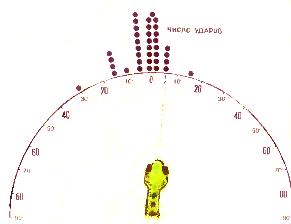Categories: Featured Articles » Interesting Facts
Number of views: 20797
Comments on the article: 0
How does the electromagnetic field smell
 In this article we will talk about living “receivers” of the electromagnetic field, about what electromagnetic waves have learned to perceive in the process of evolution living things and what kind of “devices” they have for this.
In this article we will talk about living “receivers” of the electromagnetic field, about what electromagnetic waves have learned to perceive in the process of evolution living things and what kind of “devices” they have for this.
Electromagnetic waves permeate us. Their spectrum is wide: from rays with a wavelength of less than 10 - 13 m to radio waves whose length is measured in kilometers. However, living creatures for photobiological processes use only a narrow band of the electromagnetic spectrum from 300 to 900 nm.
The Earth’s atmosphere cuts off, as a filter, life-threatening electromagnetic waves from our luminary. Rays shorter than 290 nm, hard ultraviolet, are trapped in the upper layers of the atmosphere by ozone, and the long-wave sizzling radiation is absorbed by carbon dioxide, water vapor and ozone.
In the process of evolution, "animals" appeared in many animals and even plants, which capture rays from 300 to 900 nm, among them - the eyes. Electromagnetic waves in this region of the spectrum have come to be called light. True, only a bee sees from 300 nm, it is ultraviolet light.
 We humans perceive violet only at wavelengths above 400 nm, beyond the border of 750 nm the last reflections of red disappear for us, and then the infrared region begins, in which only some nocturnal animals and even small strange creatures see them - half-monkeys ai on thin legs, with suction cups on the fingers.
We humans perceive violet only at wavelengths above 400 nm, beyond the border of 750 nm the last reflections of red disappear for us, and then the infrared region begins, in which only some nocturnal animals and even small strange creatures see them - half-monkeys ai on thin legs, with suction cups on the fingers.
Let’s go through the invisible electromagnetic spectrum and see what living “devices” were acquired during the evolution of the creature in order to perceive these most common physical fields in nature.
No matter how much we examine the smallest organisms, no matter how carefully we study the larger animals and humans, we cannot find special receptors that accept radio-frequency electromagnetic waves. We do not feel them, although they affect the general condition of a person. Apparently, living cells themselves become receivers of waves of various lengths. The shorter the wavelength, the more distinctly the body responds to them.
 For example, meter-long radio waves cause excitement in monkeys: they turn their heads in the direction of their source, begin to experience excitement. It is possible that radio waves interact with electric currents in neurons of the brain and peripheral nervous system.
For example, meter-long radio waves cause excitement in monkeys: they turn their heads in the direction of their source, begin to experience excitement. It is possible that radio waves interact with electric currents in neurons of the brain and peripheral nervous system.
Some unicellular ones are guided in relation to the transmitting radio station to certain images, especially if it is close to them. This is observed, for example, in an experiment with green flagellates euglena, which are arranged in a strict order in the direction of the antenna of the radio transmitter.
Low-frequency electromagnetic oscillations (3 Hz) after a 30-minute exposure cause experimental rabbits to increase the cortical rhythm to 8 - 10 Hz and increase the amplitude of oscillations of brain neurons by about two times, i.e. up to 70 μV. Such a violation of the electrical activity of the brain under the influence of electromagnetic field may persist up to two days after exposure.
People also do not care about artificial electromagnetic fields with a frequency of 10 Hz, although they do not feel them. Here is what an interesting experience showed, the purpose of which was to compare the activity and rhythm of life of people who were affected by an electromagnetic field and who were not exposed to it.
The experiment took place in an underground room and lasted a month. Those who were irradiated with weak electromagnetic waves did not know about this. If usually, even in a dark room, the period of human activity lasted about 25 - 26 hours, then under the influence of an electromagnetic field this period increased to 30 and even 40 hours, it seemed to people that it takes so much a day on the surface of the earth.Under the influence of an electromagnetic field, the electrolyte composition of urine and the excretory function of the kidneys of the subjects also changed.
 If we gradually reduce the length of the radio waves, then we will soon find ourselves in the infrared region, occupying in the electromagnetic spectrum a region from 700 to 1600 nm. These are thermal rays from sources, such as the sun, a red-hot furnace, a light bulb, or a bonfire. We feel them with the thermoreceptors of our skin.
If we gradually reduce the length of the radio waves, then we will soon find ourselves in the infrared region, occupying in the electromagnetic spectrum a region from 700 to 1600 nm. These are thermal rays from sources, such as the sun, a red-hot furnace, a light bulb, or a bonfire. We feel them with the thermoreceptors of our skin.
When we bring our hand closer to a person or a cat, we will also feel the warmth of these rays. But we humans, unlike some animals that nature has endowed with excellent radars, do not have live "night vision" devices that can absorb infrared rays coming from all living things, even from plants. But blood-sucking, for example, at any time of the day or night you need to search and find prey. For them, more important are not visible rays, but infrared, which allows you to remotely find the body of your future victims.
 The most common bed bug detects objects with body temperature at a distance of several meters. The "last pointing" of it to the object occurs from a closer distance - 15 cm. As you approach it, the bug drives its "antennas" in all directions. Having chosen a suction point, he turns the whole body in the direction indicated by the "antennas" and goes to the place of his "pirate actions".
The most common bed bug detects objects with body temperature at a distance of several meters. The "last pointing" of it to the object occurs from a closer distance - 15 cm. As you approach it, the bug drives its "antennas" in all directions. Having chosen a suction point, he turns the whole body in the direction indicated by the "antennas" and goes to the place of his "pirate actions".
Another bloodsucker - a tick - is equipped with a more advanced radar. Climbing to the tip of a leaf of a tree or bush, he raises the front legs and begins to lead them in different directions. On the legs you can distinguish rounded formations - this is the radar. They perceive rays a few meters from the source. When a warm-blooded animal or person approaches him, the tick falls on him and bites headlong into the skin.
An extremely simple experience is known. It is enough for a person to stick his head out of the car, as a tick at a distance of several meters detects it and begins to move in his direction. If you remove your head, while the metal case of the car acts as a screen, or put on a metal helmet, the tick loses a person, I begin to poke my head in confusion in different directions. The appearance of the head from the cab again allows him to find the right direction. Therefore, the “taiga robber” radar includes only at the last stages of a person’s search.
In the depths of the ocean there are also many animals that use the "devices" of night vision. The last glimmers of light in the water go out at a depth of 200 m, and life goes on at a 10-kilometer depth. Some creatures light their bioluminescent “flashlights” in pitch darkness, while others prefer, while remaining invisible, to pick up infrared light coming from all living things.
 Deep-sea squids, in addition to their ordinary eyes, which are very similar to human in structure, also have thermoscopic eyes that capture infrared rays. The structure of the thermoscopic eye is similar to the usual, perceiving visible to us light. There you can also find the lens, cornea, and retina. Only in this retina are receptors adapted to perceive infrared waves, and so that ordinary light rays do not interfere with the thermal radiation coming from living objects (radiation, each thermoscopic eye is equipped with a special light filter that delays all rays except infrared ones.
Deep-sea squids, in addition to their ordinary eyes, which are very similar to human in structure, also have thermoscopic eyes that capture infrared rays. The structure of the thermoscopic eye is similar to the usual, perceiving visible to us light. There you can also find the lens, cornea, and retina. Only in this retina are receptors adapted to perceive infrared waves, and so that ordinary light rays do not interfere with the thermal radiation coming from living objects (radiation, each thermoscopic eye is equipped with a special light filter that delays all rays except infrared ones.
The most interesting thing is that thermoscopic eyes are located on the tail squid. Rotating it like a head, the squid looks out for animals that can be enjoyed, as well as predators, their brethren, for example, which are often engaged in cannibalism. Yes, sometimes it’s useful to have eyes on the tail, especially night vision.
In his famous book “20 years in the bathyscaphe”, the famous underwater explorer Georges Woo notes that at a depth of 5-6 km, in the ocean abyss, where eternal darkness reigns, he met fish with well-developed eyes, they swam to the porthole of the bathyscaphe, but did not react at all to a bright beam of a searchlight. Why then do they have eyes? Maybe in this case, just to see infrared light and all those who emit it?
 Extremely poisonous rattlesnakes are found in America, and muzzles in Central Asia. Looking at these snakes, you can find four nostrils on their heads.On each side, one is normal and the other is large. This is a large depression between the eye and the nostrils - a radar, facial fossa. Snakes having it belong to the pit family.
Extremely poisonous rattlesnakes are found in America, and muzzles in Central Asia. Looking at these snakes, you can find four nostrils on their heads.On each side, one is normal and the other is large. This is a large depression between the eye and the nostrils - a radar, facial fossa. Snakes having it belong to the pit family.
Each hole is a cavity with a depth of 6 mm, opening outward with an opening with a diameter of about 3 mm. A thin membrane is stretched at the bottom of the cavity. Up to 1,500 thermoreceptors can be counted per 1 mm2 of membrane. In essence, we have a peculiar eye - an infrared pinhole camera. And since the fields of the fossae overlap and the nerve impulses entering the brain are analyzed as a whole, a kind of equivalent stereoscopic vision arises, allowing the snake to accurately determine the location of the heat source.
Checking the accuracy of location of a snake source of infrared radiation. Even if her eyes are closed, the pit snake, striking the prey, is mistaken by no more than 5 degrees. (Each hit is marked by a dark circle, on zero division - a radiation source.)

This is the structure of the facial fossa of the snake. This is essentially a pinhole camera in which infrared radiation focuses on the membrane of a fossa containing hundreds of thousands of receptors. In this case, the heat pulse is translated into a “visible” image for the snake.

Orientation of flagellates euglen in a radio frequency field. Under normal conditions, euglen movements are chaotic. If there is a source of radio waves, they orient their body towards the electromagnetic field generator.
It may seem that man-made radars are more sensitive than those created by nature. However, it is enough to compare the sizes of these devices, as it becomes obvious that the man-made is far from natural. In an artificial radar, a mirror that collects heat rays onto a special blackened film that changes its resistance depending on temperature has a diameter of more than 1 m. Contrast this giant with two facial pits on the head of a snake, the diameter of which is measured in millimeters, and you will realize that the living “device »Per unit of thermolocating area is several thousand times more sensitive.
Among infrared locators there are devices that can translate invisible rays into a visible image due to fluorescence. Such a mechanism is found in the eyes of moths. Infrared rays passing through a complex optical system focus on the pigment, which under the influence of thermal radiation fluoresces and converts the infrared image into visible light. These visible “images” are built directly in the nocturnal eye. At night, they easily find flowers that emit infrared rays.
How? They “smell” the high-frequency electromagnetic field and determine the radiation power by smell. Rather, they sense of smell trap even small amounts of ions formed after exposure to air molecules by x-rays. Apparently, only rats know how the electromagnetic field "smells" ...
Yuri Simakov
According to the materials of the journal "Youth Technology"
See also at bgv.electricianexp.com
:

